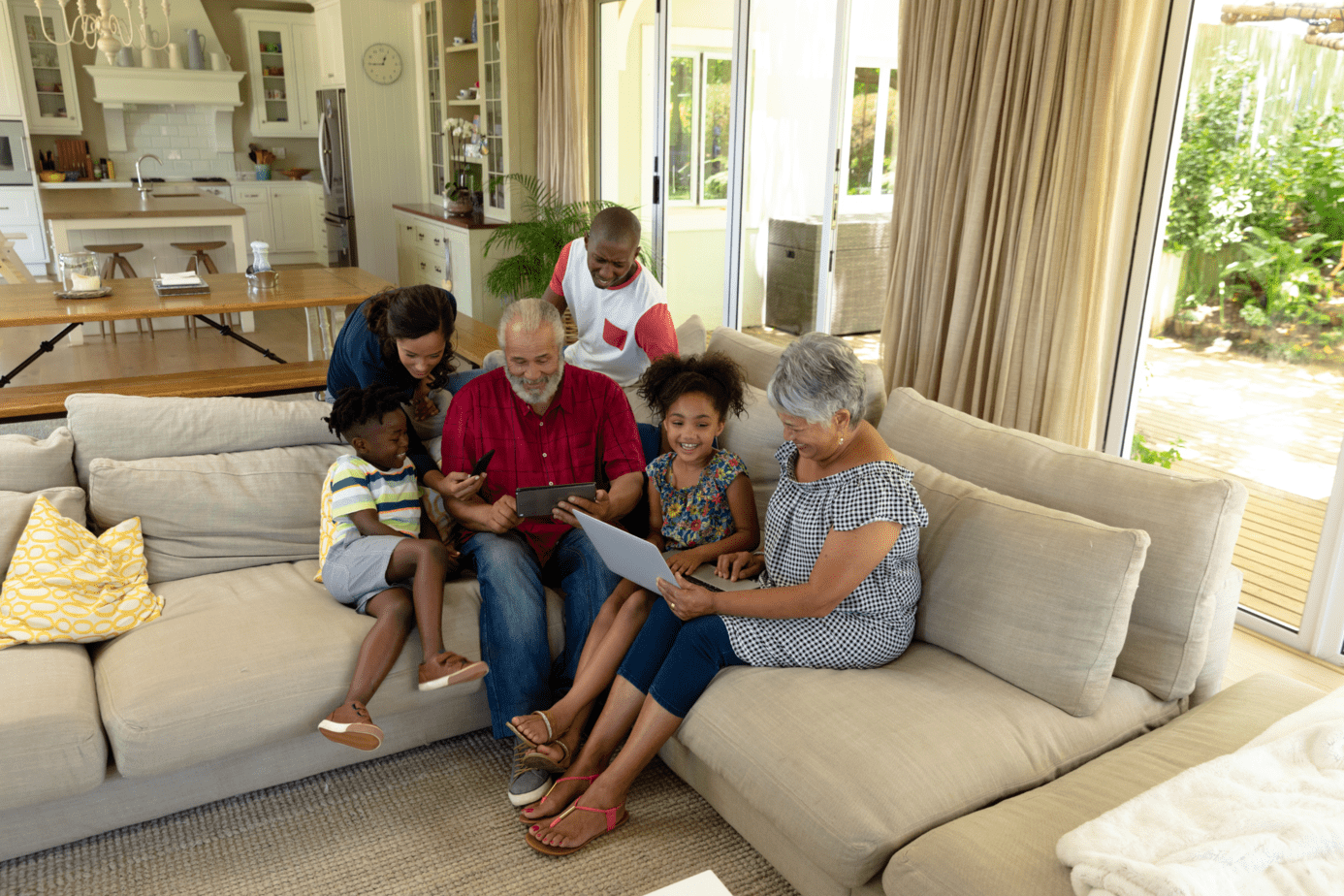What is Multigenerational Living?
It is no secret that multigenerational living is on the rise.
Multigenerational living refers to the home situation where three or more generations of a family live together.
It could be that you are living with your aging parents, adult children, grandchildren, and even partners!
More and more families are finding that there are benefits to living together under one roof.
Whatever multi-generation household looks like for you, it is important to design your home accordingly. This will ensure that everyone has their own space.
From sharing expenses to providing emotional support, multi-generational homes can be a great way to create a sense of community and connectedness.
If you are considering designing your home for multigenerational living, here are nine ways to get started!
1. Create a Common Area

One of the best ways to create a sense of community in your multi-generational home is to create a common area where everyone can gather.
This could be a living room, family room, or even just a spot in the kitchen where everyone can congregate.
Having this space will encourage interaction and give people a place to come together when they want to chat or spend time together.
2. Customize Your Spaces
When designing your multi-generational home, it is important to remember that each generation has its own needs and might want its own living space.
Try to design each space with its specific purpose in mind. For example, you may want to have a separate TV room for the adults and another playroom for the kids.
For the sake of privacy and quiet, you can also create private living spaces for all generations to have their own space.
This might include a separate suite or apartment for your elderly parents, as well as smaller bedrooms and bathrooms.
3. Add More Entryways and Exits
Suppose more than one generation lives in your home.
In that case, you may want to consider adding additional entryways and exits, making it easier for people to come and go as they please without disturbing anyone else.
Try adding a back door or side entrance that leads directly into the kitchen so that guests can enter through this room if they prefer not to use an interior door inside of the house.
If possible, create multiple entrances from outside, like sliding patio doors leading into different parts of your multi-generational home (like bedrooms).
The added options give every family member their own space when needed but also provide them with access when necessary!
You could even add another set of stairs leading up from downstairs so that multigenerational families don’t need to use one staircase.

4. Make Your Home Accessible for All Ages
When designing your home for multigenerational living, consider making it accessible for all ages; this means adding ramps or railings in the right places and removing any obstacles that might cause a tripping hazard.
You could even consider installing an elevator if you have multiple stories!
The multigenerational living space should be as easy to navigate as possible no matter what someone’s age is – whether they’re young kids running around or older adults with mobility issues (or both).
Make sure there are plenty of lighting options too!
Older adults require 70 percent more light than younger individuals.
Lighting can impact how people feel inside their own homes; make this area light up when it’s dark outside for a warm and welcoming feeling.
Have you considered smart lights?
These types of lights can be controlled remotely by phone or tablet, which means multi-generational families don’t need to worry about getting up at night to turn off the smart lights.
5. Create Separate Areas for Sleeping and Living
When designing multi-generational homes, it is important to create separate areas for sleeping and living; this will help avoid any conflicts between family members and give everyone their own space.
You may want to consider having different floor plans or room layouts for each generation – this can be as simple as giving the kids their own bedrooms on one side of the house while the older family members have their own bedroom on the other side.
If you are short on space, try using dividers like curtains or screens to create more privacy in shared spaces.
6. Include Plenty of Storage Space
Another key element when designing multi-generational homes is adding plenty of storage space; this will come in handy for all of the extra stuff that comes with having more people living under one roof!
You may want to consider adding built-in storage units or even just installing more cabinets and shelves.
Having plenty of storage space will help keep your home organized and clutter-free, which is always a plus, especially when multiple generations live together.
7. Create Outdoor Spaces for Gathering
One of the best things about multi-generational homes is that they often have plenty of outdoor spaces for gathering; this could be a patio, deck, porch, or garden where everyone can relax and spend time together.
These spaces are perfect for hosting barbecues, parties, and other get-togethers – it’s like having an extra living room! Plus, they’re a great way to enjoy the beautiful weather when it’s nice outside.
8. Think About Your Home’s Aesthetics
When designing multi-generational homes, it is important to think about your home’s aesthetics; this doesn’t mean that everything has to be matchy-matchy or super formal – try to create a cohesive look throughout the house.
You might want to use the same paint colors in different rooms or choose furniture with similar styles. By doing this, you’ll help make your multi-generational home feel like one unified space rather than several separate areas.
9. Add Separate Spaces for Working and Relaxing
In addition to creating separate spaces for sleeping and living, you may also want to add separate areas for working and relaxing; this could be a home office or an extra living room where people can escape from their busy lives.
These additional spaces can be used for different purposes – the home office can be a place for older adults to work on their laptops, while the extra living room can be used as a playroom for kids.
Having these separate spaces will help keep everyone’s areas of the house distinct and organized.
10. Think About Your Home’s Layout

When designing your home for multigenerational living, it is important to think about its layout.
This means considering things like how many floors your house has and how many rooms are available.
You might want to consider using open floor plans so that everyone can easily move around the house.
If your home has multiple floors, try to design the living areas on one floor and the bedrooms on another – this will make it easier for older family members or those with mobility issues to get around.
11. Make Sure There are Plenty of Amenities
When designing multi-generational homes, it is important to make sure there are plenty of amenities: this means adding things like a kitchen, dining room, laundry room, and bathrooms.
By having these essential rooms in your home, you’ll make life much easier for everyone who lives there!
Plus, it’s always nice to have a few extra amenities like a pool or hot tub to enjoy when the weather is nice.
12. Consider Your Home’s Climate Control Needs
When designing multi-generational homes, it is important to consider your home’s climate control needs: this means thinking about how much heat or air conditioning you’ll need throughout the year and where these rooms should be located.
For example, an upstairs bedroom might not get enough sunlight during the winter months, so installing windows on this side of the house could help keep things warm inside while letting natural light come through as well!
You may also want to install ceiling fans in areas that tend to get hot, like kitchens or bathrooms, because they won’t circulate cool air as effectively without them being present.
13. Make Sure There are Plenty of Bathrooms
When designing multi-generational homes, it is important to ensure there are plenty of bathrooms: this will ensure everyone can use the bathroom simultaneously without having to wait!
You might want to consider adding an extra bathroom if your home doesn’t currently have one; this can be especially helpful if you have a lot of people living in your home.
Plus, it’s always nice to have a few extra amenities like a pool or hot tub to enjoy when the weather is nice.

Final Thoughts
Creating a home that is accessible for all ages and able to accommodate the needs of any family member can be difficult.
But with some planning, you will soon find your space becoming more livable and comfortable for everyone in it.
Remember to think about multigenerational living when designing multi-generational homes so that your new home will be able to adapt as time goes on!
There are many ways to design multi-gen homes. There are also different types of multi-gen houses available today, such as the duplex, townhouse, or triplex styles.
The most common floor plan would be one story with two bedrooms and bathrooms along with an open kitchen/living area downstairs, while upstairs has a master suite plus another bedroom for guests (if needed).
Having three levels may work better if you have children because they can play on their own level without bothering anyone else.
Make sure all doors leading into these rooms lead directly outside so no one is ever confused about where they should go!
Consider multi-generational homes as an option for your family!
Have we missed anything?
Let us know if there are other ways to make your home look better!

